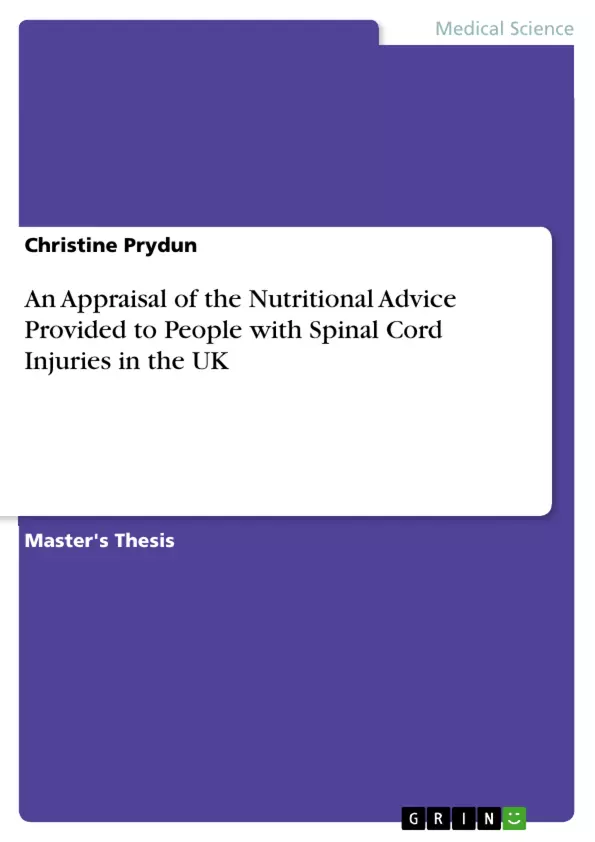The present work focuses on the nutritional advice provided to people with spinal cord injuries in the UK. People with spinal cord injuries (SCI) have unique nutritional needs due to their predisposition to obesity and chronic diseases, bowel and bladder related health concerns, pressure sores and osteoporosis. Currently there are no evidence-based nutrition guidelines provided for this neglected group and with approximately 40,000 people with SCI in the UK, this is a cause for concern. The overall aim of this project is to appraise the nutritional advice provided to adults with SCI, living in the UK and to identify limitations with this advice. Multiple methods are selected: Sources of nutritional advice (n=11) are selected by purposive sampling and compared for "consistency" using directed content analysis.
A cross-sectional, web-based survey is provided to people with SCI (n=69) via convenience sampling and enables their views to be investigated regarding the "adequacy" and "relevance" of nutritional advice provided to them. Their responses are analysed using simple frequency counts and basic content analysis. The results of the analysis of the webbased survey reveal inadequacies regarding the nutritional advice that people with SCI had been provided with in terms of its delivery, timing, form, content and extent to which it was approved by people with SCI; it also shows that secondary health conditions were "very important" determinants of food choice for people with SCI, thus potentially encouraging them to follow nutritional advice. Nutritional advice provided to people with SCI in the UK shows great inconsistency. There is also limited evidence to suggest that it is inadequate but relevant for people with SCI to follow. Due to these findings the health of people with SCI is at great risk.
People with SCI are predisposed to becoming overweight and obese, because paralysis is thought to decrease their energy requirements, by affecting all three components of energy expenditure.
Inhaltsverzeichnis (Table of Contents)
- Introduction
- Spinal Cord Injuries (SCI)
- Unique nutritional needs
- Nutrition for Secondary Health problems
- Obesity and chronic diseases
- Bowel Management problems
- Bladder Management problems
- Pressure Sores
- Osteoporosis
- Nutritional advice for people with SCI
- Aims and objectives of the project
- Methods
- Study design
- Comparison of Nutritional Advice
- Identification of Nutritional Advice
- Analysis
- Cross-sectional Survey
- Survey Design and Sampling
- Analysis
- Ethical considerations
- Results
- Available Nutritional advice
- Consistency of Nutritional advice
- Adequacy and Relevance of Nutritional advice
- Adequacy of 'given' advice
- Adequacy of 'found' advice
- Perceptions of Adequacy
- Adequacy of learnt advice
- Relevance of Nutritional advice
- Discussion
- Consistency
- Adequacy and Relevance
- Limitations
- Recommendations and Conclusions
- Appendices
Zielsetzung und Themenschwerpunkte (Objectives and Key Themes)
This project aims to assess the nutritional advice provided to adults with Spinal Cord Injuries (SCI) living in the UK and identify its limitations. The study explores the consistency, adequacy, and relevance of this advice by analyzing various sources of information and conducting a survey among individuals with SCI.
- The consistency of nutritional advice provided to people with SCI.
- The adequacy and relevance of nutritional advice for people with SCI.
- The key limitations of current nutritional advice for people with SCI.
- The impact of secondary health conditions on food choices for people with SCI.
- Recommendations for improving the quality and effectiveness of nutritional advice for people with SCI.
Zusammenfassung der Kapitel (Chapter Summaries)
The introduction establishes the unique nutritional needs of individuals with SCI, highlighting their susceptibility to obesity, chronic diseases, and specific health concerns related to bowel and bladder management, pressure sores, and osteoporosis. The chapter outlines the project's aim to evaluate the nutritional advice provided to this population and identify its limitations.
The "Methods" chapter details the study's design, which includes analyzing various sources of nutritional advice and conducting a web-based survey among individuals with SCI. The analysis techniques used to assess the consistency, adequacy, and relevance of the advice are explained.
The "Results" chapter presents the findings of the study, revealing inconsistencies in the nutritional advice provided to people with SCI. The survey results demonstrate the inadequacy and limited relevance of the advice received by individuals with SCI. The study also highlights the significant role of secondary health conditions in shaping food choices for people with SCI.
The "Discussion" chapter analyzes the implications of the findings, emphasizing the importance of developing evidence-based nutritional guidelines for people with SCI. The chapter suggests the need for greater standardization and collaboration among organizations providing advice, and underscores the crucial role of research in protecting the health of individuals with SCI.
Schlüsselwörter (Keywords)
This research focuses on the nutritional needs and advice provided to individuals with spinal cord injuries, considering their susceptibility to obesity, chronic diseases, and secondary health conditions. The study analyzes various sources of nutritional advice and conducts a survey to assess the consistency, adequacy, and relevance of this advice. The project highlights the importance of evidence-based nutritional guidelines and the need for research to ensure the health and well-being of people with SCI.
- Quote paper
- Christine Prydun (Author), 2008, An Appraisal of the Nutritional Advice Provided to People with Spinal Cord Injuries in the UK, Munich, GRIN Verlag, https://www.grin.com/document/458718



